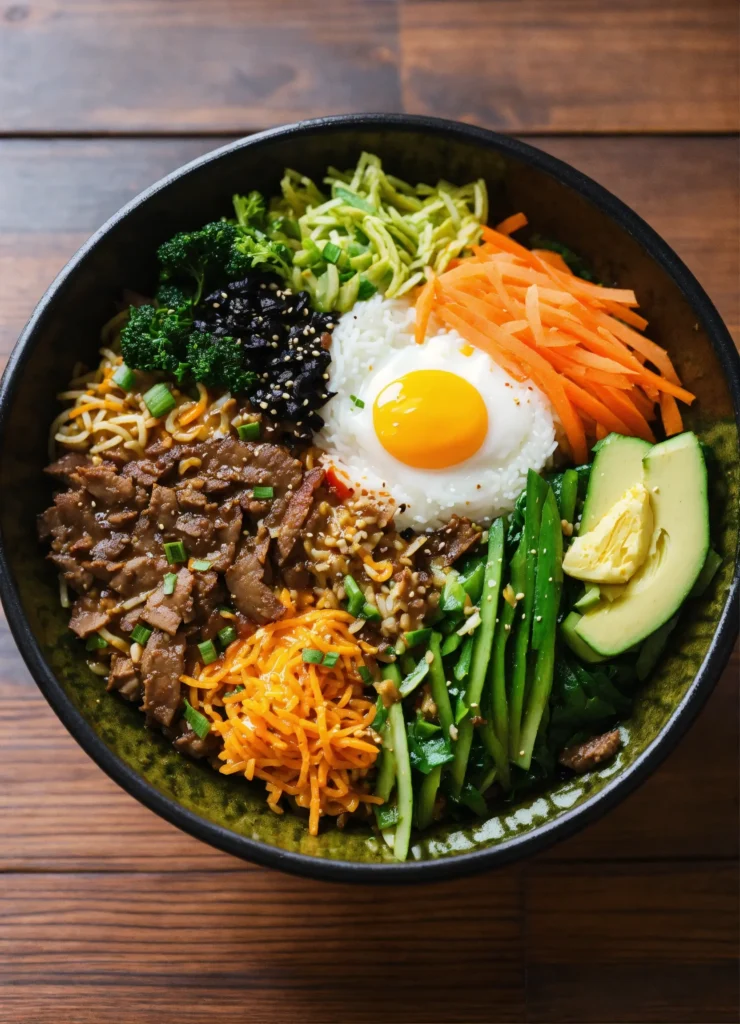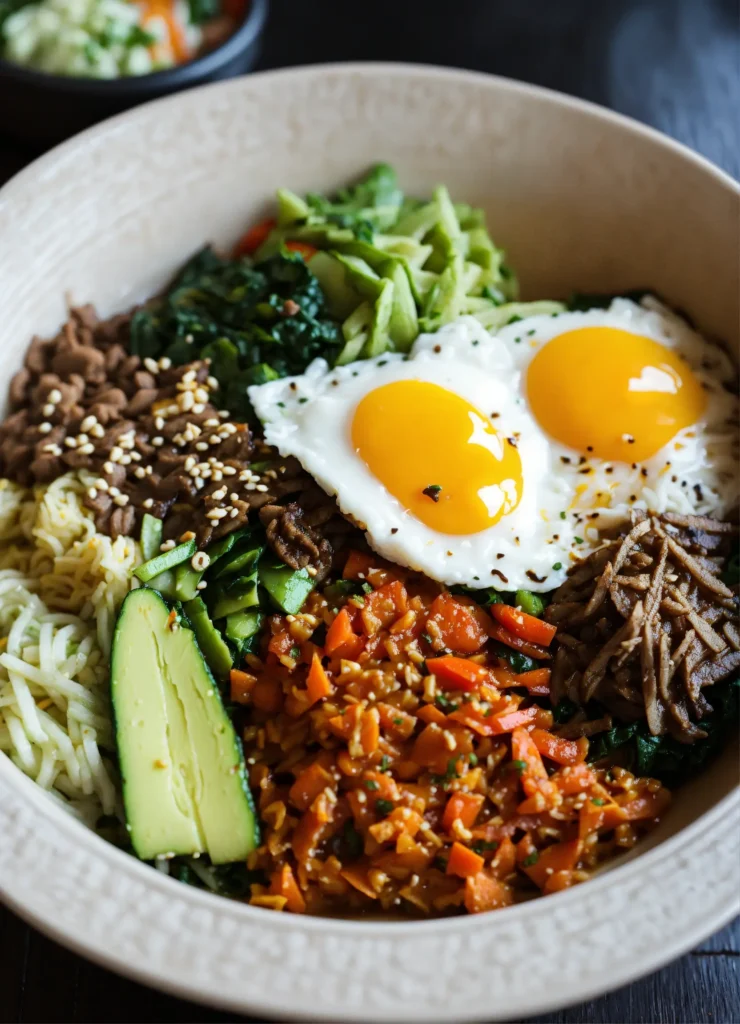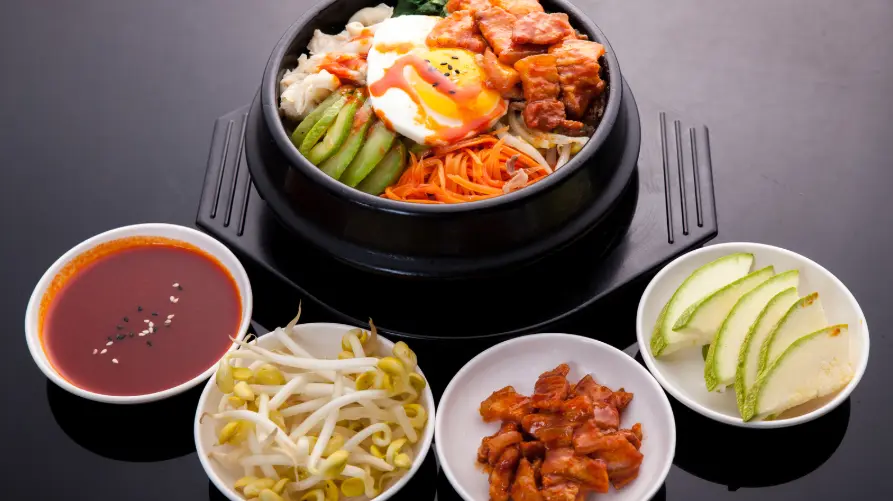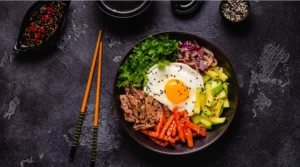
How to Make Bibimbap (Korea), one of Korea’s most iconic dishes, is a vibrant and delicious meal that perfectly balances flavor, texture, and nutrition. Translating to “mixed rice,” this dish combines steamed rice, seasoned vegetables, protein, and spicy-sweet gochujang sauce for a satisfying culinary experience.
What is Bibimbap?
Bibimbap is a traditional Korean dish that consists of a bowl of warm rice topped with a variety of seasoned vegetables, protein options like beef, tofu, or eggs, and a dollop of gochujang (Korean chili paste). The ingredients are stirred together before eating, creating a harmonious mix of flavors and textures. This dish is deeply rooted in Korean culture and history, often enjoyed during special occasions and celebrations.
Table of Contents
Key Ingredients for Bibimbap
Here’s a list of essential ingredients to create an authentic bibimbap:
| Ingredient | Quantity | Purpose |
|---|---|---|
| Cooked white rice | 2 cups | Base of the dish |
| Spinach (blanched) | 1 cup | Provides vibrant green color and flavor |
| Carrots (julienned) | 1 cup | Adds sweetness and crunch |
| Bean sprouts | 1 cup | Offers a fresh, crisp texture |
| Shiitake mushrooms | ½ cup (sliced) | Adds umami flavor |
| Zucchini (julienned) | 1 cup | Provides subtle sweetness |
| Bulgogi (marinated beef) or tofu | 200g | Protein source |
| Egg (fried or raw) | 1 | Traditional topping |
| Gochujang (chili paste) | 2 tablespoons | Signature sauce for flavor |
| Sesame oil | 1 tablespoon | Enhances aroma and taste |
| Sesame seeds | 1 teaspoon | Adds nuttiness |
How to Prepare Bibimbap – Step-by-Step Recipe

- Prepare the Rice:
- Cook white rice according to package instructions and keep warm.
- Cook the Vegetables:
- Blanch spinach and season with a pinch of salt and sesame oil.
- Sauté julienned carrots, zucchini, and shiitake mushrooms separately with sesame oil and a pinch of salt.
- Blanch the bean sprouts and lightly season.
- Prepare the Protein:
- Cook bulgogi (marinated beef) in a hot pan until tender, or sauté tofu until golden.
- Assemble the Bowl:
- Place a generous serving of rice at the bottom of a large bowl.
- Arrange the vegetables and protein around the rice in sections for a visually appealing presentation.
- Add a fried or raw egg on top.
- Add the Sauce:
- Place a dollop of gochujang in the center and drizzle with sesame oil.
- Mix and Enjoy:
- Stir all ingredients together thoroughly before eating.
Tips for Perfect Bibimbap
- Presentation Matters: Arrange ingredients in a visually appealing manner for an authentic experience.
- Customize Your Protein: Substitute beef with chicken, pork, seafood, or tofu based on your preference.
- Balance the Flavors: Adjust the amount of gochujang to suit your spice tolerance.
- Use a Hot Stone Bowl: For an authentic Korean experience, use a dolsot (hot stone bowl) to create crispy rice at the bottom.
Variations of Bibimbap
- Vegetarian Bibimbap: Omit meat and add more mushrooms or tofu for a plant-based option.
- Seafood Bibimbap: Include shrimp, squid, or fish for a seafood twist.
- Kimchi Bibimbap: Add kimchi for a tangy, spicy flavor.
- Brown Rice Bibimbap: Use brown rice or quinoa for a healthier alternative.
- Fusion Bibimbap: Experiment with non-traditional ingredients like avocado, kale, or roasted vegetables.
Nutritional Benefits of Bibimbap
Bibimbap is a well-balanced meal that provides:
- Carbohydrates: Energy from the rice base.
- Proteins: Sourced from meat, tofu, or eggs.
- Vitamins and Minerals: Abundant in vegetables like spinach, carrots, and zucchini.
- Healthy Fats: Sesame oil adds heart-healthy fats.

FAQ Section How to Make Bibimbap
What is the origin of bibimbap?
Bibimbap has its roots in Korean royal cuisine, where it was served as a luxurious and visually striking dish.
Can I make bibimbap vegetarian?
Yes, simply omit the meat and use tofu or additional vegetables as protein substitutes.
Is bibimbap spicy?
The level of spiciness depends on the amount of gochujang used. Adjust to your preference.
Can I use leftover rice for bibimbap?
Yes, leftover rice works well. Reheat it before assembling the dish.
Where can I buy gochujang?
Gochujang is available at most Asian grocery stores or online.
Conclusion
Bibimbap is more than just a meal; it’s an experience that brings together the flavors and traditions of Korea. Whether you prefer a classic recipe or a creative variation, bibimbap is a versatile dish that can cater to any palate. Try making this vibrant dish at home and enjoy a taste of Korea’s rich culinary heritage.
For more delicious recipes, tips, and food stories, subscribe to our newsletter and explore the world one dish at a time!
when you try the meal, give us your opinion
reviews
There are no reviews yet. Be the first one to write one.
